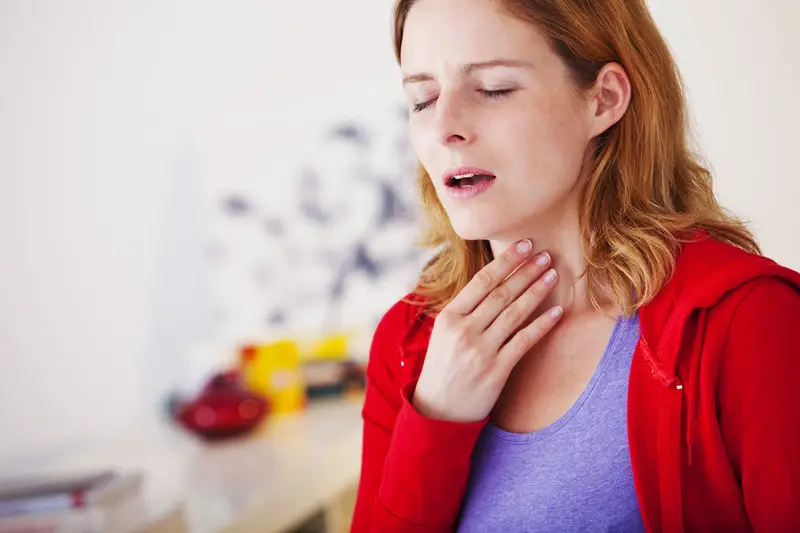Mucus helps protect the body against germs, bacteria, and other environmental pollutants present in the air.
Mucus in the throat can occur as a result of an underlying health condition such as asthma, common cold, allergies, etc., or due to certain environmental factors such as dry air, low water intake, and smoking.
In traditional Chinese medicine, the lungs are seen as the first line of defense against infections. If the lungs’ qi gets weakened, or if there is a deficiency, it can lead to the accumulation of mucus in the throat.
Depending on the cause, acupressure is used to stimulate certain acupoints to help treat and balance lung qi deficiency in the body.
Does Acupressure Help With Mucus In Throat?
Excess mucus in the throat, post-nasal drip, running nose, catarrh, and sneezing are all symptoms associated with allergic rhinitis, COPD, asthma, etc. Rhinitis, in general, has to do with the swelling of the mucous membrane, which is responsible for producing mucus.
Traditional Chinese medicine employs the use of acupuncture and acupressure to treat rhinitis. Applying pressure to certain acupressure points for mucus in the throat will help relieve accumulated mucus in the throat (post-nasal drip).
In a clinical study carried out in 2010, acupuncture was used in the treatment of chronic rhinitis. Rhinitis is a nasal congestion problem normally associated with excess mucus production.
In the study, 85 patients with chronic rhinitis were treated using acupuncture. Among these 85 cases, there were 61 males and 24 females, out of which 79 had previously received medications.
Certain acupuncture points for mucus in the throat treatment, such as GB-20, LI-4, and ST-36, were stimulated using filiform needles of 40–50 mm in height and 0.35 mm in diameter.
There was a 96.5 recovery rate after two courses of acupuncture treatment were administered. 61 of the patients experienced a full recovery, while 21 patients showed signs of improvement. Only 3 cases showed no signs of improvement.
In another 2015 systematic review and meta-analysis, the clinical efficacy of acupuncture in the treatment and management of allergic rhinitis was tested.
The systematic review made use of 13 selected studies that met its inclusion criteria. These 13 studies had a combined number of 2365 participants, where 1126 were used as the acupuncture treatment group, with 1239 serving as the control group. When compared, the acupuncture treatment group showed significant improvement and a reduction in nasal symptoms.
Participants in the acupuncture treatment group showed a massive reduction in the symptoms associated with allergic rhinitis, leading to the conclusion that acupuncture could be a safe treatment option for allergic rhinitis.
How To Relieve Excess Mucus In Throat With Acupressure
Lots of studies have shown that acupuncture as well as acupressure can be used to treat or lessen the symptoms of COPD, sinusitis, or rhinitis.
Medically, antihistamines, antibiotics, and other inflammatory drugs are used to treat various sinus infections, but using acupuncture alongside these other medications has proven to be even more effective.
Stimulating certain acupressure points for mucus in the throat can help reduce symptoms such as mucus in the throat, post-nasal drip, sneezing, and running nose caused by sinusitis or rhinitis.
To achieve this, follow these simple steps.
- Using a mirror, locate the various acupressure points for throat mucus removal on your face.
- Apply firm pressure gently on these pressure points with your thumb, fingers, or any blunt object, stimulating them for at least 3 minutes each.
- Repeat this multiple times per day for several days.
You can perform these procedures yourself or seek the services of a professional acupressurist.
What Are The Acupressure Points For Mucus in The Throat
There are many acupressure points along the lung and stomach meridian that aids in relieving the effects of various respiratory problems. We will look at the six best and easy-to-access acupressure points for throat mucus removal.
Acupoint: Ren-22 (Other Names: The Conception Vessel-22/Tian Tu/Heaven Projection)
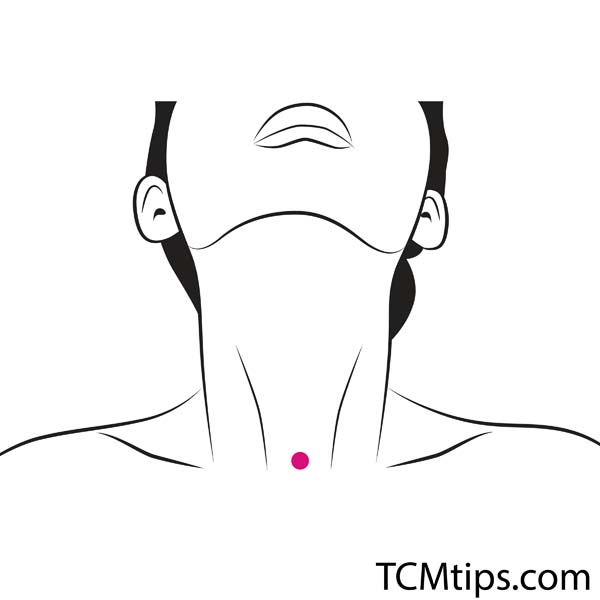
The Ren-22 is also known as Tiantu, which translates to celestial prominence. It is located on the anterior median line of the neck, right in the center of the suprasternal fossa.
This is a great pressure point for mucus in the throat as it helps to clear and resolve phlegm problems, helps regulate breathing, helps stop coughing, and also benefits the throat in general. Ren-22 also helps in subduing rebellious lung qi caused as a result of reactions to allergies.
This acupoint is mostly used by acupuncturists and acupressurists in the treatment of bronchitis, cough, and asthma and to relieve sore throats, hiccups, and difficulty swallowing. It also serves as a great acupressure point for throat inflammation.
Acupoint: EM-20 (Other Names: Ding Chuan)
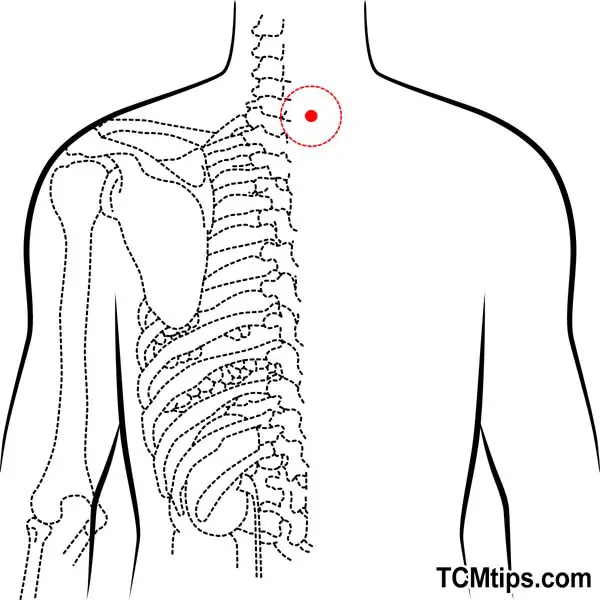

The EM-20 is also known as DingChuan in Chinese, which translates to “stop asthma.” It is a great acupuncture point for treating asthma and cough. It is located at the back of the neck, 0.5 cun lateral to the lower part of the spinous process of the number 7 cervical vertebra.
Stimulating this acupoint helps calm asthma and cough, which have post-nasal drip as one of their symptoms. It also helps to dispel wind from the lungs, which helps to regulate qi and blood.
DingChuan is also used to treat sore throats, shortness of breath, coughs, and oppression of the chest. It also serves as a great acupressure point for lung treatment.
Acupoint: GV-14 (Other Names: The Governing Vessel-14/Da Zhui/Great Vertebra)
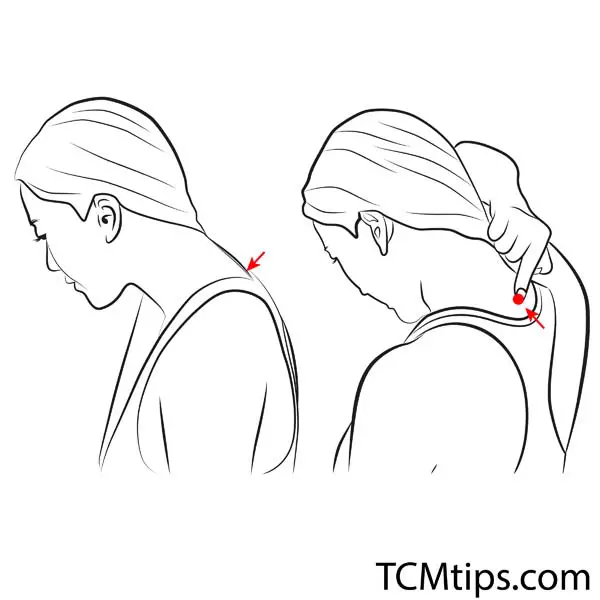
The GV-14 is also known as Dashui in Chinese, which translates to the Great Hammer. It is located below the spinous process of the number seven cervical vertebrae, around the level of the shoulder.
The GV-14 is a great acupressure point for mucus in throat treatment as stimulating it helps clear heat, expel wind, regulate defensive qi, and tonifies the yang. The GV-14 is the meeting point where all the yang channels meet, thus responsible for tonifying the wei qi and stimulating the adrenal cortex.
The GV-14 is also used for acupressure for sinus inflammation treatments, fever, cough, neck and shoulder pain, back stiffness and rigidity, etc.
Acupoint: Bl-13 (Other Names: Urinary Bladder-13/Fei Shu/Lung Transporter)
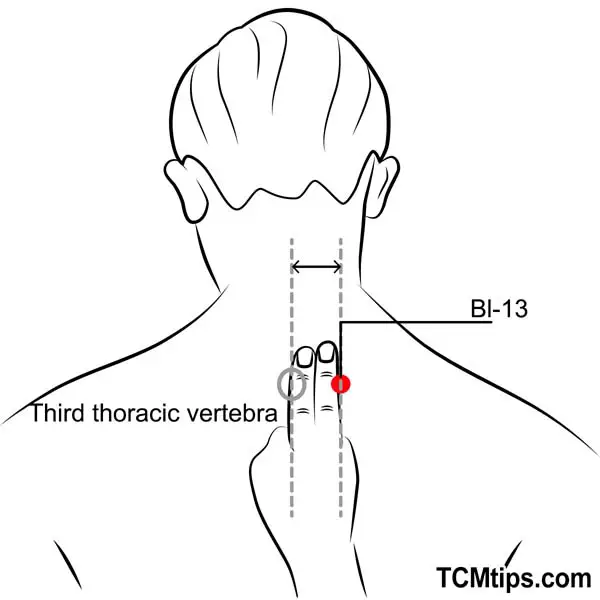
The BL-13, also known as Feishu in Chinese, translates to Lungs Hollow. It is located 1.5 cun lateral to GV-12, at the lower border of the spinous process of the third thoracic vertebrae. When it comes to acupressure for mucus in throat clearing or removal, the BL-13 is a great acupoint.
When stimulated, the BL-13 regulates the descending and dispersing functions of the lungs, which helps to fight against nasal congestion and post-nasal drip. It also helps to strengthen and regulate the lungs’ qi, stops coughing, clears lung heat, treats dyspnea in COPD patients, and opens the chest, making it a great acupressure point for chest pain.
Due to the effects BL-13 has on the lungs, it serves as an excellent acupoint for treating chronic obstructive pulmonary disease and bronchial asthma. According to this study, BL-13, used alongside other bilateral acupoints like BL-23, LU-1, LU-9, LI-18, ST-36, GB-12, and BL-20, can help reduce dyspnea or shortness of breath symptoms in patients suffering from COPD.
Acupoint: Bl-23 (Other Names: Urinary Bladder-23/Shen Shu/Kidney Transporter)
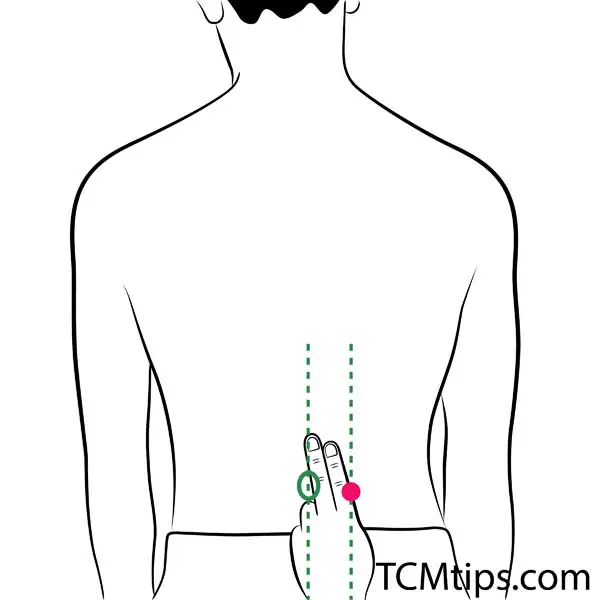
The BL-23 is known as Shenshu in Chinese, which translates to the Kidney Shu or Kidney Hollow. It can be located 1.5 cun lateral to GV-4, around the lower border of the spinous process of the second lumbar vertebra.
Stimulating the BL-23 has a regulating effect on the respiratory system and can help to dispel heat and dampness from the body. In addition, it strengthens the lower back, helps to tonify the kidney, nourishes the kidney, and also strengthens its ability to grasp qi.
This is an important acupressure point for inflammation treatments and for treating different health problems such as low back pain, weakness of the knee, edema, asthma, cough, etc.
Acupoint: LU-9 (Other Names: Lung-9/Tai Yuan/Supreme Abyss)
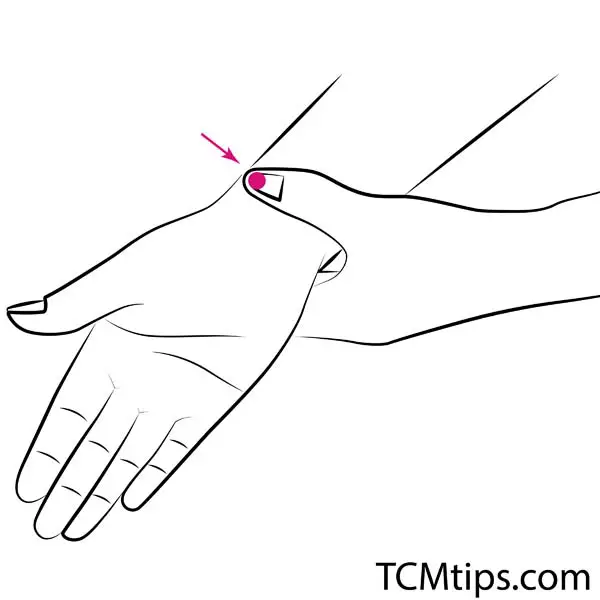
The LU-9 is also called “Taiyuan” in Chinese, which translates to “Great Abyss.” It is located at the radial end of the transverse crease of the wrist, where the lateral artery pulsates.
It can help resolve phlegm, tonify the lungs’ qi and yin, clear lungs and liver heat, influence pulse, and help control blood circulation when properly stimulated. All these help to relieve post-nasal drip in patients suffering from sinusitis and rhinitis.
Other benefits of using this acupoint are that it helps in treating coughs, asthma, sore throats, and palpitations. It is also employed in acupuncture for wrist tendonitis.
Conclusion
Accumulated mucus in the throat, or post-nasal drip, as it is popularly known, is a symptom of respiratory problems such as sinusitis or rhinitis. By using acupressure to treat these problems, you can significantly reduce the symptoms you are experiencing. All 6 acupoints discussed above are great for reducing post-nasal drip and can either be self-administered or done by a professional.
- Ren-22 helps in subduing rebellious lung qi caused as a result of reactions to allergies.
- EM-20 helps to dispel winds from the lungs, which helps to regulate qi and blood.
- GV-14 helps clear heat, expel wind, regulates defensive qi, and tonifies the yang. It is the meeting point where all the yang channels meet, thus responsible for tonifying the wei qi and stimulating the adrenal cortex.
- Bl-13 helps to strengthen and regulate the lungs’ qi, clears lung heat, treats dyspnea in COPD patients, and opens the chest.
- Bl-23 helps to dispel heat and dampness from the body, tonify and nourish the kidney, and strengthen its ability to grasp qi.
- LU-9 tonifies the lungs’ qi and yin, clears lungs and liver heat, influences pulse, and helps control blood circulation.

Try our Anti-Aging Gua Sha Tool designed to bring out your skin’s natural glow.
Best Gua Sha Product- Anti-Aging: The tool is designed to target 11 specific aging signs such as wrinkles and sagging skin. By following the 7-step routine, users can improve skin firmness and reduce fine lines naturally.
- Enhances Skincare Routine: It works effectively with serums and lotions, boosting absorption and efficacy of skincare products.
- Visible Skin Improvement: Users can expect a smoother complexion, reduced puffiness, and a more youthful appearance.
 P. Sze
P. Sze 